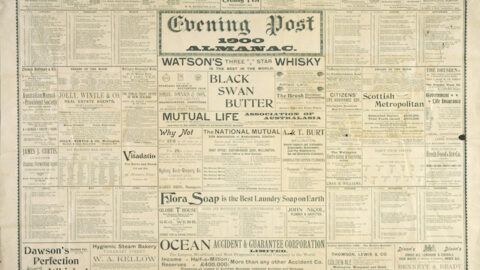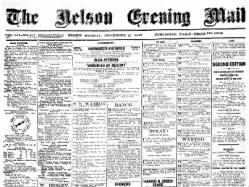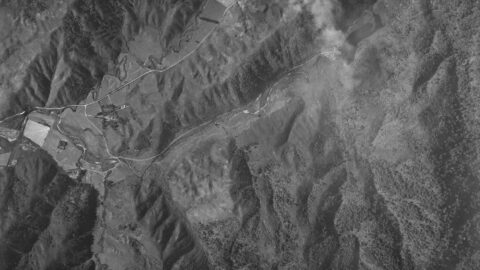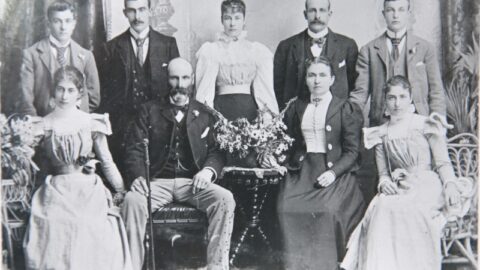THE WAINUI-O-MATA WATER SUPPLY.
MR LOUGHREY IN REPLY
The following is a précis of the City Surveyor’s report on the Wainui-o-mata waterworks, in reply to the reports of Messrs Higginson, Baird and Ward, and Stewart on the same subject:
Mr Loughrey commences his report as follows:
“Herein I have doubtless anticipated the wish of the Committee that I shall reply to certain statements contained in a report sent in by Messrs Baird and Ward, in accordance with a request of the Committee that Mr J. D. Baird, late City Surveyor, should reply to several paragraphs in the report of Mr H. P. Higginson on the Wainui-o-mata waterworks; but as the report contains grave misstatements and misrepresentations reflecting on myself, I thought it advisable that they should be contradicted without delay.
Up to the present time professional etiquette has prevented me from saying anything about the works of my predecessor, but on reading the report, and noting its general tenor both to misstate and distort, I intend to prove, by comparing it with actual facts, that such misstatements have been either wilful, or that neither Mr Baird nor his assistant knows how the Wainui works were actually carried out.”
Mr Loughrey states with regard to the shutter of the sluice tunnel that the design was never altered. It is of a similar description to that at the entrance to the race, but even that, with only 5ft of water against it, is not watertight.
As previously reported to the Committee, he did not consider it either necessary or advisable to recommend that the water should be shut off for a fortnight from the city to substitute a proper valve until a more efficient supply could be obtained from Karori, more especially as there was always such a volume of water running to waste over the bywash, with the exception of the few weeks at the beginning of the present year.
As to the specification for pipe-laying across the Wainui river bed, Mr Loughrey said that he never saw it and was given to understand that it is not in the Council office. As regards other plans and documents prepared for Mr Clark, the City Surveyor remarks that he has only to say that Mr Higginson received all that could be found in the office, and those which he could not obtain were not, as asserted by Mr Baird, in the office.
With reference to the well, Mr Loughrey says:
“I am perfectly certain, from the pressures registered in Wellington, that for a few days before the water was shut off from Wainui, there was air in the pipes from the well to the tunnel, and had it not been for the attention bestowed by the custodian, some bursts would have occurred, and this was the main reason that I recommended that the water should be shut off, so that the reservoir should get a chance to gain, and the well thus be kept supplied, and the water reach the higher levels.
It is a matter of impossibility, under existing arrangements, to so regulate the supply to the well that it is always just full and no more; the consequence is that one of the two following things must happen:—Either water will run to waste over the bywash, or else, as the water goes down in the well, air must be taken into the pipes.”
In reply to Mr Baird’s objection, “that the storage would be at the most ten days,” raised by Mr Baird at Mr Loughrey’s recommendation to extend the pipes from the well to the reservoir, Mr Loughrey says:
“It is well to know that there would be so much storage, not allowing for any supply running in during that time, but as an actual fact, and one apparently forgotten by Mr Baird, there are over 3,000,000 gallons per diem, at its lowest, flowing down the Wainui Stream; and the question is, how long would that storage last backed up by this 3,000,000 gallons per diem? It doesn’t require a great knowledge of mathematics to see that it would last a great number of ten days even at the present rate of consumption.”
Mr Loughrey quotes the paragraph in Messrs Baird and Ward’s report, containing the main cause of complaint against him, as follows:
“That I must have known that Mr Baird never had an opportunity of testing these works at all, as he left the Corporation before the water was turned into the race, the dam not being finished at the time. He (Mr Baird) would naturally have carefully tested the race, viz., in the only possible way, by turning on the water to it before he declared the works were finished, and allowed the water to be turned on into town permanently, and in the event of leaks appearing, which no doubt they have done from the first, he would have taken immediate steps to repair them, and not allowed them to go on increasing without taking any steps at all for a period of 3½ years.”
In reply, Mr Loughrey states that the following are the actual facts:
“I arrived in Wellington on the 1st February, 1884. The race was completed, maintained, and final payment made on January 18th, 1883 (more than 12 months before my arrival in the Colony). I can prove, both by documentary evidence and living witnesses, if necessary, that water was flowing in the race from early in August, 1883 (six months before my arrival in the Colony), until the dam washed away on 22nd January, 1884. Also, that the line of pipes from the well to Petone was tested from a small stream let into the race near the dam, and several bursts took place (altogether six—four 30in and two 24in mains).
The first, a crack in the 30in main in Coleman’s tunnel, at Wainui-o-mata, on 18th September, 1883, and which was repaired on that and following days. Also, that a landslip occurred along the line of race, and a timber breastwork had to be constructed, and was commenced on 10th November, 1883. That at this place I found the race cracked when going through it on 27th February last.
Also, that the proposed airshaft on the Wainui side of the tunnel was commenced by guesswork on 2nd September, 1883, when four lengths (36ft) of 6in cast-iron pipes were fixed, when it was found, after the water was turned on, that it was not high enough, and that the water flowed over it instead of along the mains. It was then heightened by adding two lengths (about 14ft) of plain galvanised iron pipe, and water still flowed over it; and at last it had to be abandoned, as there were no means of raising it higher and properly staying it; and it was then taken down on 14th November, 1883, by Mr Baird’s orders, and a hydrant valve substituted for it (the self-acting valve mentioned by Mr Higginson).
Also, that Mr G. H. Baylis, contractor for the completion of the dam, was in the habit of using the race for the purpose of letting off the flood waters, which could not escape through the sluice tunnel, and that I can prove he did this in September, 1883, and various other times, with Mr Baird’s sanction, when the race was running quite full.
Also, that Mr Baird was making arrangements with Mr Baylis to fill the dam at the end of December, 1883, so that the pipes could be charged through the race.
Also, that on the 19th January, 1884, Mr Baylis filled the dam up, the work being virtually taken over from him, in order that the pipes could be carefully charged and the water brought into Wellington on Anniversary Day, 22nd January, 1884. That as an actual fact the water was running in the race from the dam on the 20th and 21st January, 1884, and the pipes were charged to Petone, when a burst took place in the long tunnel, and also one on Petone beach, and on the following day the dam was washed away.
That if the flood had not washed away the dam, Baylis would have received his final certificate from Mr Baird on the 23rd of January, 1884, and the water would have been permanently in the town had no bursts taken place in the pipes in the meantime.
Also, that Mr Ward, at the end of January of the present year, told me in the office at the storeyard (in course of conversation about the apparent leaks in race), in the presence of Mr Kerslake, the general overseer, that there was always a leak in the place where I afterward found the 25ft crack, and they couldn’t understand it. Yet we are now told how Mr Baird would have carefully tested the race, and what he would have done had he the opportunity, when in reality he had such opportunity and never availed himself of it, although leaks were known to exist, but which were not repaired, and these facts were carefully concealed from me.
The above facts require very little comment from me, as they speak for themselves; but I am now certain, from what I have since been told, that some of those cracks were there before the work was completed, and yet Mr Baird never thought of sending anybody through to examine the race, even while it was dry, to ascertain if any subsidence had taken place in it, and the only way I can account for it is that he never intended it to be necessary.
As a matter of fact, no examination could be made of the sluice valve or the race, or repairs, if necessary, effected without cutting off the water altogether from the higher levels of the city, and no convenient opportunity up to the present time has presented itself for this, as even in the winter months the supply from the distributing basin at Polhill’s Gully wouldn’t reach the higher levels of the city any more than it did in the summer months; and the only time to do this without inconvenience would be, as I previously reported to the Council, when the 12in mains were extended to connect with Karori Reservoir.”
Again, as to their complaint that Mr Higginson was not apparently informed that there were two air shafts, one on each side of the tunnel, the City Surveyor replies that it was simply because there is actually only one at the Wellington side of the tunnel, the other only existing in Messrs Baird and Ward’s imagination.
Tags: Coleman's Tunnel Dams Newspaper Water Race Waterworks





